Did you know that humble fava beans are the secret star of Greek cuisine? These creamy, versatile legumes transform into everything from comforting dips to vibrant salads and hearty stews. Whether you’re craving quick weeknight dinners or impressive Mediterranean feasts, these 25 recipes will make you fall in love with fava beans. Let’s dive into these delicious Greek-inspired creations that will brighten your table!
Classic Greek Fava Bean Dip

Zesty yet sophisticated, this Classic Greek Fava Bean Dip transforms humble legumes into a velvety, sun-kissed spread that captures the essence of Mediterranean simplicity. With its creamy texture and subtle earthy sweetness, it serves as both an elegant appetizer and a versatile condiment. Perfect for entertaining or quiet moments of indulgence, this dip invites you to savor the authentic flavors of the Greek islands.
3
servings15
minutes55
minutesIngredients
– 1 cup dried yellow split fava beans, carefully rinsed
– 4 cups cold filtered water
– 1 medium yellow onion, finely diced
– 2 cloves fresh garlic, minced
– 1/3 cup rich extra virgin olive oil, plus more for drizzling
– 2 tbsp freshly squeezed lemon juice
– 1 tsp fine sea salt
– 1/2 tsp freshly ground black pepper
– Fresh chopped parsley for garnish
Instructions
1. Place 1 cup dried yellow split fava beans in a fine-mesh strainer and rinse thoroughly under cold running water for 1 minute to remove any dust or debris.
2. Transfer the rinsed beans to a medium saucepan and add 4 cups cold filtered water, ensuring the beans are fully submerged.
3. Bring the water to a rolling boil over high heat, then immediately reduce the heat to maintain a gentle simmer.
4. Using a slotted spoon, carefully skim off and discard the white foam that rises to the surface during the first 5 minutes of cooking.
5. Add 1 finely diced medium yellow onion and 2 minced cloves of fresh garlic to the saucepan.
6. Simmer uncovered for 45-50 minutes, stirring occasionally with a wooden spoon, until the beans are completely tender and beginning to break apart.
7. Tip: Maintain a consistent simmer rather than a vigorous boil to prevent the beans from becoming mushy on the outside while remaining firm inside.
8. Drain the cooked bean mixture through a fine-mesh strainer, reserving 1/4 cup of the cooking liquid.
9. Transfer the drained beans and vegetables to a food processor and add 1/3 cup rich extra virgin olive oil, 2 tbsp freshly squeezed lemon juice, 1 tsp fine sea salt, and 1/2 tsp freshly ground black pepper.
10. Process the mixture on high speed for 2-3 minutes, scraping down the sides with a rubber spatula halfway through, until completely smooth and creamy.
11. Tip: If the dip appears too thick, gradually add the reserved cooking liquid 1 tablespoon at a time while processing until your desired consistency is achieved.
12. Taste and adjust seasoning if necessary, remembering that flavors will continue to develop as the dip cools.
13. Transfer the dip to a serving bowl, cover with plastic wrap, and refrigerate for at least 2 hours to allow the flavors to meld and the texture to firm slightly.
14. Tip: For optimal flavor development, prepare the dip at least 4 hours ahead of serving and bring it to room temperature for 30 minutes before presenting.
15. Just before serving, drizzle with additional extra virgin olive oil and garnish generously with fresh chopped parsley.
Offering a luxuriously smooth texture that contrasts beautifully with crisp vegetable crudités, this dip reveals layers of earthy bean flavor brightened by citrus notes. The gentle heat of fresh garlic and the fruity richness of olive oil create a harmonious balance that lingers pleasantly on the palate. Consider serving it alongside warm pita triangles or as an unexpected accompaniment to grilled fish for a truly memorable culinary experience.
Lemon and Herb Fava Bean Salad
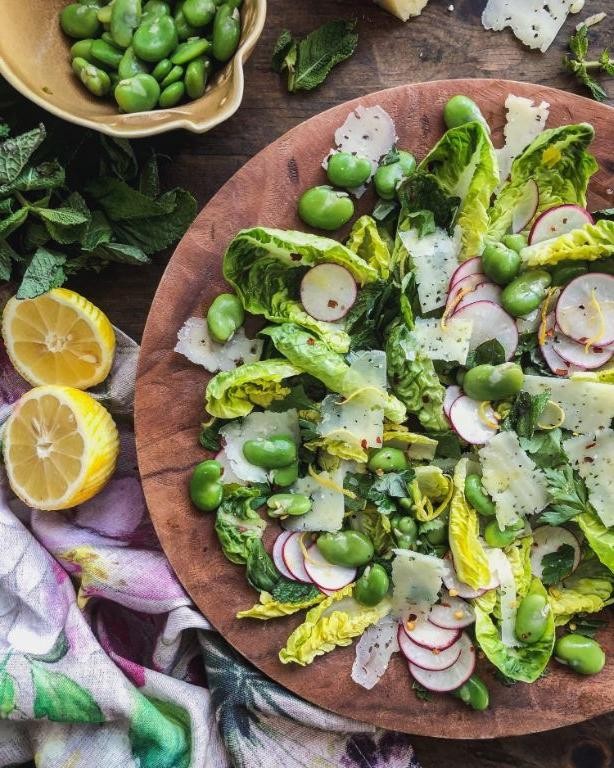
Perfectly balancing bright citrus notes with earthy spring legumes, this Lemon and Herb Fava Bean Salad celebrates the fleeting season when fresh fava beans grace farmers’ markets. The vibrant combination of zesty lemon, aromatic herbs, and tender beans creates a dish that feels both sophisticated and refreshingly simple. It’s an elegant starter or side that transforms humble ingredients into something truly special.
2
servings25
minutes2
minutesIngredients
– 2 cups shelled fresh fava beans
– 1/4 cup freshly squeezed lemon juice
– 1/3 cup rich extra virgin olive oil
– 1/4 cup finely chopped fresh mint leaves
– 2 tablespoons chopped fresh dill
– 1/2 teaspoon flaky sea salt
– 1/4 teaspoon freshly cracked black pepper
– 4 cups mixed baby greens
– 1/2 cup crumbled creamy feta cheese
Instructions
1. Bring a large pot of salted water to a rolling boil over high heat.
2. Add the shelled fresh fava beans and blanch for exactly 2 minutes until bright green and slightly tender.
3. Immediately transfer the beans to an ice water bath using a slotted spoon to stop the cooking process.
4. Peel the thin outer skins from each fava bean by gently squeezing one end until the bright green inner bean pops out.
5. In a medium bowl, whisk together the freshly squeezed lemon juice and rich extra virgin olive oil until emulsified.
6. Stir in the finely chopped fresh mint leaves and chopped fresh dill until well combined.
7. Add the peeled fava beans to the dressing and toss gently to coat completely.
8. Season the bean mixture with flaky sea salt and freshly cracked black pepper, then let marinate for 15 minutes at room temperature.
9. Arrange the mixed baby greens on a large serving platter or individual plates.
10. Spoon the marinated fava beans and dressing evenly over the greens.
11. Top with crumbled creamy feta cheese just before serving.
Zesty lemon dressing clings to each tender fava bean, while the fresh herbs provide aromatic bursts that complement the creamy feta beautifully. The salad offers a delightful contrast between the crisp greens and the soft, buttery beans, making it perfect alongside grilled fish or as part of a spring brunch spread. For an elegant presentation, serve it in wide, shallow bowls to showcase the vibrant colors and textures.
Greek Fava Bean Soup with Dill
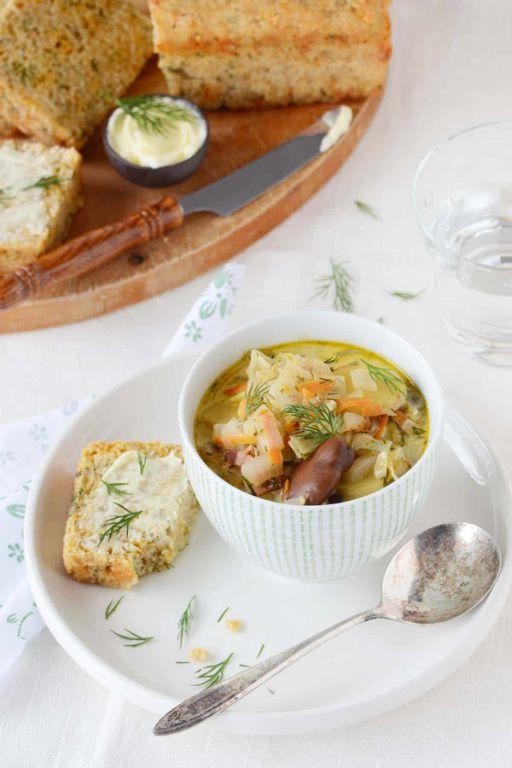
A velvety embrace of Mediterranean tradition, this golden-hued fava bean soup captures the essence of Greek sunshine in every spoonful, where humble legumes transform into luxurious comfort. An elegant balance of earthy beans and bright herbal notes makes this dish both nourishing and sophisticated, perfect for crisp autumn evenings. As the dill unfurls its feathery fragrance, it whispers of coastal villages and generations of cherished family recipes.
5
servings15
minutes58
minutesIngredients
– 1 cup dried yellow split fava beans
– 2 tablespoons rich extra virgin olive oil
– 1 medium yellow onion, finely diced
– 2 cloves fresh garlic, minced
– 4 cups homemade vegetable broth
– 1 bay leaf, aromatic and whole
– ¼ cup freshly chopped dill, feathery and fragrant
– 1 tablespoon freshly squeezed lemon juice
– ½ teaspoon fine sea salt
– ¼ teaspoon freshly cracked black pepper
Instructions
1. Rinse 1 cup dried yellow split fava beans under cold running water until the water runs clear.
2. Place the rinsed beans in a medium bowl and cover with 3 inches of cold water; soak for 8 hours or overnight.
3. Drain the soaked beans thoroughly and transfer them to a heavy-bottomed Dutch oven.
4. Heat 2 tablespoons rich extra virgin olive oil in the Dutch oven over medium heat until shimmering.
5. Add 1 medium finely diced yellow onion and sauté for 5-7 minutes until translucent and fragrant.
6. Stir in 2 cloves minced fresh garlic and cook for 1 minute until aromatic but not browned.
7. Pour in 4 cups homemade vegetable broth and add the drained fava beans along with 1 whole aromatic bay leaf.
8. Bring the mixture to a boil over high heat, then immediately reduce to a gentle simmer.
9. Partially cover the pot and simmer for 45 minutes, stirring occasionally to prevent sticking.
10. Remove the bay leaf and discard it carefully.
11. Using an immersion blender, puree the soup directly in the pot until completely smooth and velvety.
12. Stir in ¼ cup freshly chopped feathery dill, 1 tablespoon freshly squeezed lemon juice, ½ teaspoon fine sea salt, and ¼ teaspoon freshly cracked black pepper.
13. Simmer for an additional 5 minutes to allow the flavors to meld together beautifully.
Freshly blended to silken perfection, this soup offers a luxurious texture that coats the spoon like liquid gold. The earthy depth of fava beans provides a robust foundation, while the bright dill and lemon create vibrant top notes that dance on the palate. For an elegant presentation, drizzle with extra virgin olive oil and garnish with additional dill fronds, serving alongside crusty artisanal bread for dipping into this Mediterranean masterpiece.
Fava Bean Saganaki with Tomato and Feta
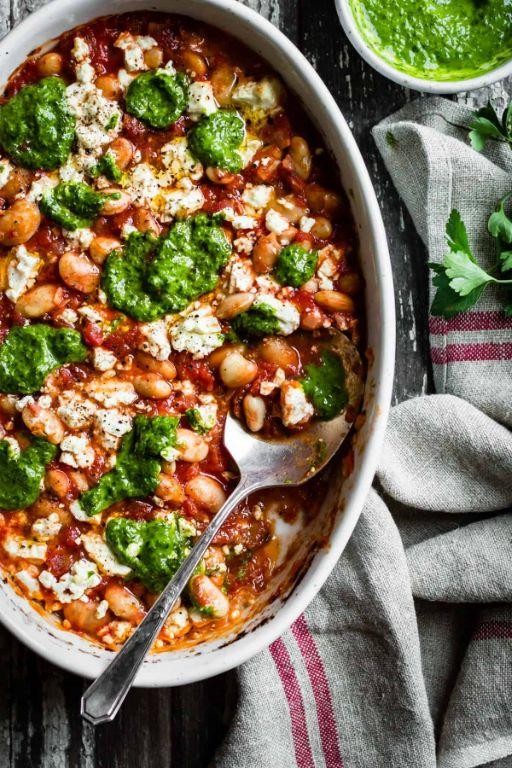
Elevating humble legumes to new heights, this vibrant fava bean saganaki celebrates Mediterranean flavors through a harmonious union of creamy beans, sweet tomatoes, and briny cheese. The dish transforms simple ingredients into a sophisticated yet comforting preparation that sings with bright, layered complexity.
4
servings20
minutes20
minutesIngredients
- 2 cups shelled fresh fava beans
- 1/4 cup rich extra virgin olive oil
- 1 medium yellow onion, finely diced
- 2 garlic cloves, thinly sliced
- 1 1/2 cups ripe cherry tomatoes, halved
- 1/4 cup dry white wine
- 4 ounces high-quality feta cheese, crumbled
- 2 tablespoons fresh oregano leaves
- 1/2 teaspoon flaky sea salt
- 1/4 teaspoon freshly cracked black pepper
- Crusty artisan bread for serving
Instructions
- Bring a medium pot of salted water to a rolling boil over high heat.
- Blanch the shelled fresh fava beans for 2 minutes until their skins begin to loosen.
- Immediately transfer the beans to an ice water bath using a slotted spoon to stop the cooking process.
- Peel away the outer skins from each fava bean to reveal the bright green inner beans.
- Heat the rich extra virgin olive oil in a large skillet over medium heat until shimmering.
- Sauté the finely diced yellow onion for 5-7 minutes until translucent and fragrant.
- Add the thinly sliced garlic cloves and cook for 1 minute until aromatic but not browned.
- Stir in the halved ripe cherry tomatoes and cook for 3-4 minutes until they begin to soften and release their juices.
- Pour in the dry white wine, scraping any browned bits from the bottom of the skillet.
- Simmer the mixture for 2 minutes until the wine reduces by half.
- Gently fold in the peeled fava beans, coating them evenly with the tomato mixture.
- Sprinkle the flaky sea salt and freshly cracked black pepper over the ingredients.
- Cook undisturbed for 4-5 minutes until the beans are tender but still retain a slight bite.
- Remove the skillet from heat and immediately top with the crumbled high-quality feta cheese.
- Garnish with fresh oregano leaves just before serving.
- Serve directly from the skillet with slices of crusty artisan bread for dipping.
Delightfully textured with creamy beans against the tangy feta and sweet tomato base, this dish offers a symphony of Mediterranean flavors. The vibrant colors and aromatic herbs make it equally suited for elegant entertaining or casual weeknight dining, particularly when paired with crisp rosé and good company.
Mediterranean Fava Bean Stew

Unfolding with the gentle warmth of Mediterranean sunshine, this fava bean stew captures the soulful essence of coastal cooking, where humble legumes transform into a velvety, herb-kissed masterpiece that nourishes both body and spirit. Each spoonful whispers of sun-drenched terraces and generations of culinary tradition, making this dish perfect for both weeknight comfort and elegant entertaining.
2
servings15
minutes45
minutesIngredients
– 2 tablespoons rich extra virgin olive oil
– 1 large yellow onion, finely diced
– 3 cloves aromatic garlic, minced
– 1 teaspoon fragrant ground cumin
– ½ teaspoon smoked paprika with earthy notes
– 4 cups rich vegetable broth
– 2 cups frozen fava beans, thawed
– 1 large ripe tomato, finely chopped
– 2 tablespoons freshly squeezed lemon juice
– ¼ cup finely chopped fresh parsley
– 1 teaspoon coarse sea salt
– ½ teaspoon freshly cracked black pepper
Instructions
1. Heat the rich extra virgin olive oil in a heavy-bottomed Dutch oven over medium heat until shimmering.
2. Add the finely diced yellow onion and cook for 8-10 minutes, stirring occasionally, until translucent and fragrant.
3. Stir in the minced aromatic garlic and cook for 1 minute until golden but not browned.
4. Sprinkle the fragrant ground cumin and earthy smoked paprika over the onion mixture, toasting the spices for 30 seconds to release their essential oils.
5. Pour in the rich vegetable broth, scraping any browned bits from the bottom of the pot to build flavor.
6. Add the thawed fava beans and finely chopped ripe tomato to the simmering liquid.
7. Bring the stew to a gentle boil, then reduce heat to low and cover partially.
8. Simmer for 25-30 minutes, until the fava beans are tender but still hold their shape.
9. Stir in the freshly squeezed lemon juice, which will brighten the stew’s flavor profile.
10. Fold in the finely chopped fresh parsley just before serving to preserve its vibrant color.
11. Season with coarse sea salt and freshly cracked black pepper, adjusting until perfectly balanced.
Luxuriously creamy yet maintaining the fava beans’ delicate structure, this stew offers layers of earthy cumin, bright lemon, and sweet tomato notes that meld into profound comfort. Serve it alongside crusty artisan bread for dipping, or elevate it with a dollop of tangy Greek yogurt and a drizzle of peppery olive oil for contrasting textures that celebrate Mediterranean simplicity.
Oven-Roasted Fava Beans with Garlic
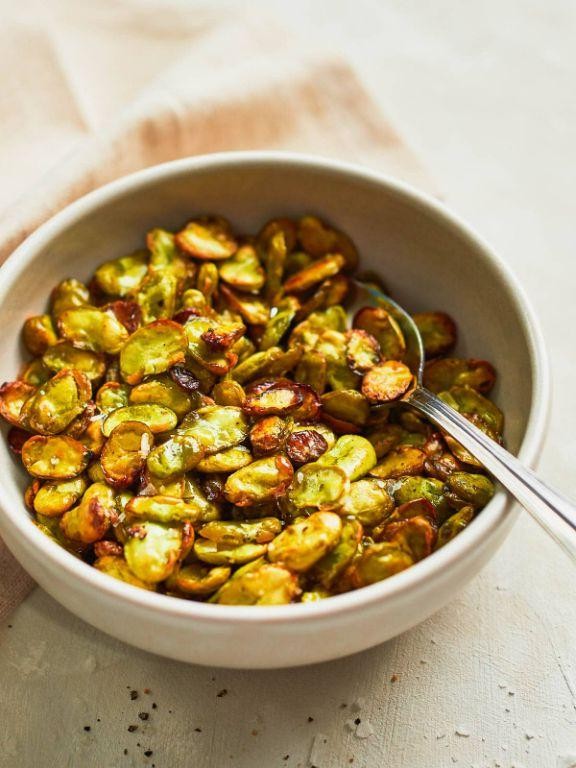
Vibrant and sophisticated, these oven-roasted fava beans transform humble legumes into an elegant side dish worthy of any dinner party. With garlic-infused olive oil and a crisp, golden finish, they offer both visual appeal and complex flavor layers that will impress even the most discerning palates.
4
servings10
minutes20
minutesIngredients
– 2 pounds fresh fava beans in their pods
– 3 tablespoons rich extra virgin olive oil
– 4 cloves aromatic garlic, thinly sliced
– 1 teaspoon coarse sea salt
– ½ teaspoon freshly cracked black pepper
– 1 tablespoon fresh lemon juice from a bright citrus
– 2 tablespoons finely chopped fresh parsley
Instructions
1. Preheat your oven to 425°F and position a rack in the center of the oven.
2. Rinse the fresh fava beans thoroughly under cold running water to remove any dirt or debris.
3. Pat the bean pods completely dry with clean kitchen towels to ensure proper crisping during roasting.
4. Place the dried fava bean pods in a large mixing bowl and drizzle with the rich extra virgin olive oil.
5. Add the thinly sliced aromatic garlic, coarse sea salt, and freshly cracked black pepper to the bowl.
6. Toss everything together with your hands until each pod is evenly coated with the oil and seasonings.
7. Arrange the seasoned fava bean pods in a single layer on a large rimmed baking sheet, ensuring they don’t overlap.
8. Roast in the preheated 425°F oven for 18-20 minutes, until the pods are slightly charred and tender when pierced with a fork.
9. Remove the baking sheet from the oven and immediately drizzle the bright fresh lemon juice over the hot beans.
10. Sprinkle the finely chopped fresh parsley evenly across the roasted fava beans.
11. Transfer the roasted fava beans to a serving platter, making sure to include all the crispy garlic slices from the baking sheet.
Exquisitely textured with crisp-tender pods and creamy interior beans, these garlicky delights offer a satisfying crunch followed by buttery softness. The caramelized garlic slices provide sweet, aromatic notes that beautifully contrast with the bright lemon finish, making them perfect served alongside grilled fish or as an unexpected appetizer with artisan bread for dipping into the flavorful oil.
Savory Greek Fava Bean Pancakes

Heralding from the sun-drenched shores of the Mediterranean, these savory Greek fava bean pancakes offer a sophisticated twist on traditional breakfast fare, blending creamy legume richness with aromatic herbs in a dish that feels both rustic and refined. Here, humble ingredients transform into golden, crisp-edged delights that capture the essence of Greek culinary tradition with every satisfying bite.
8
pancakes15
minutes24
minutesIngredients
– 1 cup dried yellow split fava beans, soaked overnight
– 1/4 cup rich extra-virgin olive oil, plus more for frying
– 1/3 cup finely chopped fresh dill
– 1/4 cup thinly sliced scallions
– 2 farm-fresh large eggs, lightly beaten
– 1/4 cup all-purpose flour
– 1 tsp coarse sea salt
– 1/2 tsp freshly cracked black pepper
– 1/2 tsp smoked paprika
– 1 lemon, cut into wedges for serving
Instructions
1. Drain the soaked fava beans thoroughly and transfer them to a food processor.
2. Pulse the beans for 45 seconds until they form a coarse, grainy paste, scraping down the sides once to ensure even texture.
3. Add the rich extra-virgin olive oil, finely chopped fresh dill, thinly sliced scallions, farm-fresh large eggs, all-purpose flour, coarse sea salt, freshly cracked black pepper, and smoked paprika to the processor.
4. Blend the mixture for 60 seconds on medium speed until fully combined and slightly fluffy.
5. Heat a large non-stick skillet over medium heat and add 1 tablespoon of olive oil, swirling to coat the surface evenly.
6. Drop 1/4-cup portions of the batter into the hot skillet, spacing them 2 inches apart to allow for spreading.
7. Cook the pancakes for 3-4 minutes until the edges appear set and the bottoms develop a deep golden-brown crust.
8. Carefully flip each pancake using a thin spatula and cook for another 3 minutes until the second side is equally golden and the centers feel firm to the touch.
9. Transfer the cooked pancakes to a wire rack to maintain crispness, repeating the process with remaining batter and adding more olive oil as needed.
10. Serve the pancakes immediately with lemon wedges for squeezing over the top.
Just moments from skillet to plate, these pancakes boast a delightfully crisp exterior that gives way to a creamy, herb-flecked interior, with the bright acidity of lemon cutting through the earthy bean base. Consider stacking them high with a dollop of tangy yogurt or pairing with a simple tomato-cucumber salad for a complete Mediterranean-inspired meal that celebrates texture and balance in every forkful.
Fava Bean and Tzatziki Tart

Zestfully bridging Mediterranean tradition with contemporary pastry artistry, this elegant tart transforms humble ingredients into a sophisticated centerpiece. The crisp, buttery crust provides the perfect canvas for creamy tzatziki and vibrant fava beans, creating layers of texture and flavor that sing of spring. Each slice offers a harmonious balance between rich dairy notes and the earthy sweetness of legumes, finished with aromatic herbs that dance on the palate.
6
portions40
minutes23
minutesIngredients
– 1 ¼ cups all-purpose flour
– ½ cup cold European-style butter, cubed
– 3 tablespoons ice water
– 1 cup fresh fava beans, shelled
– 1 cup thick Greek yogurt
– ½ English cucumber, grated and thoroughly drained
– 2 cloves garlic, finely minced
– 2 tablespoons fresh dill, chopped
– 1 tablespoon fresh mint leaves, thinly sliced
– 1 tablespoon extra virgin olive oil
– ½ teaspoon fine sea salt
– ¼ teaspoon freshly cracked black pepper
– 1 large egg, lightly beaten for egg wash
Instructions
1. Combine 1 ¼ cups all-purpose flour and ¼ teaspoon fine sea salt in a food processor.
2. Add ½ cup cold cubed European-style butter and pulse until the mixture resembles coarse crumbs with pea-sized butter pieces remaining.
3. Drizzle in 3 tablespoons ice water while pulsing just until the dough begins to clump together—be careful not to overmix.
4. Turn the dough onto a floured surface and gently press into a disc, then wrap in plastic and refrigerate for 30 minutes to relax the gluten.
5. Blanch 1 cup shelled fresh fava beans in boiling water for 2 minutes, then immediately transfer to an ice bath to preserve their vibrant green color.
6. Peel the outer skins from the blanched fava beans to reveal the tender inner beans.
7. Roll the chilled dough into a 10-inch circle on a floured surface, then carefully transfer to a tart pan.
8. Press the dough firmly into the pan’s edges and trim any excess, then prick the bottom all over with a fork.
9. Line the crust with parchment paper and fill with pie weights, then blind bake at 375°F for 15 minutes.
10. Remove the parchment and weights, then brush the crust with beaten egg wash and bake for another 8 minutes until golden brown.
11. Combine 1 cup thick Greek yogurt, ½ grated and drained English cucumber, 2 minced garlic cloves, 2 tablespoons chopped dill, 1 tablespoon sliced mint, 1 tablespoon olive oil, ¼ teaspoon fine sea salt, and ¼ teaspoon black pepper in a bowl.
12. Spread the tzatziki mixture evenly over the cooled tart crust.
13. Arrange the peeled fava beans artfully over the tzatziki layer.
14. Chill the assembled tart for at least 1 hour to allow the flavors to meld and the filling to set.
Yielding a symphony of textures, the crisp pastry shatters to reveal the cool, creamy tzatziki punctuated by the pop of tender fava beans. The garlic and herbs provide a bright counterpoint to the rich dairy base, creating a refreshing yet substantial dish perfect for alfresco dining. Consider serving alongside grilled lamb chops or as part of a meze platter with marinated olives and warm pita bread for a complete Mediterranean experience.
Creamy Fava Bean Puree with Olive Oil
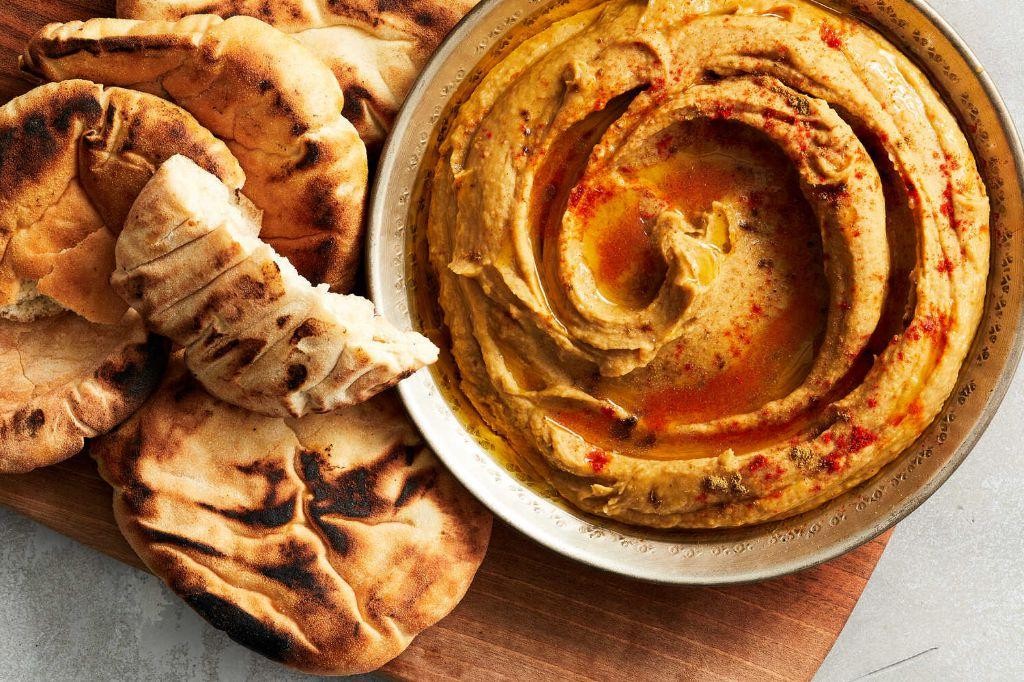
Elegant in its simplicity yet profound in flavor, this creamy fava bean puree transforms humble legumes into a sophisticated spread worthy of any gathering. With its velvety texture and earthy undertones, it serves as a versatile canvas for the bright, peppery notes of quality olive oil. This Mediterranean-inspired dish celebrates the pure essence of its ingredients while offering endless pairing possibilities.
2
servings15
minutes3
minutesIngredients
– 2 cups shelled fresh fava beans
– 3 tablespoons rich extra virgin olive oil
– 1 small garlic clove, finely minced
– 2 tablespoons freshly squeezed lemon juice
– 1/4 cup ice-cold water
– 1/2 teaspoon flaky sea salt
– Freshly cracked black pepper
Instructions
1. Bring a medium pot of salted water to a rolling boil over high heat.
2. Carefully add the shelled fresh fava beans to the boiling water and cook for exactly 3 minutes until bright green and tender.
3. Immediately transfer the cooked fava beans to an ice water bath using a slotted spoon to stop the cooking process.
4. Gently peel the thin outer skins from each fava bean by pinching one end and squeezing the bright green bean out.
5. Combine the peeled fava beans, finely minced garlic, and flaky sea salt in a food processor.
6. Pulse the mixture 8-10 times until the beans are roughly broken down but not yet smooth.
7. With the processor running on low speed, slowly drizzle in 2 tablespoons of rich extra virgin olive oil through the feed tube.
8. Add the freshly squeezed lemon juice and continue processing for 30 seconds until incorporated.
9. Gradually stream in the ice-cold water while the processor runs until the puree reaches a smooth, spreadable consistency.
10. Transfer the puree to a serving bowl and create shallow swirls on the surface with the back of a spoon.
11. Drizzle the remaining tablespoon of rich extra virgin olive oil over the puree in a circular motion.
12. Generously sprinkle with freshly cracked black pepper and let rest for 10 minutes to allow flavors to meld. For optimal creaminess, ensure all ingredients are at room temperature before blending. The ice water bath is crucial for preserving the fava beans’ vibrant color and preventing overcooking. Creating texture with the back of a spoon helps the olive oil pool beautifully in the grooves. Finished with a final flourish of olive oil, this puree achieves a luxurious silkiness that contrasts wonderfully with the occasional whole bean. Its earthy depth makes it exceptional spread on crusty bread or as an elegant dip for crisp vegetables. For a stunning presentation, serve alongside grilled lamb chops or as part of a Mediterranean meze platter.
Grilled Fava Bean Skewers
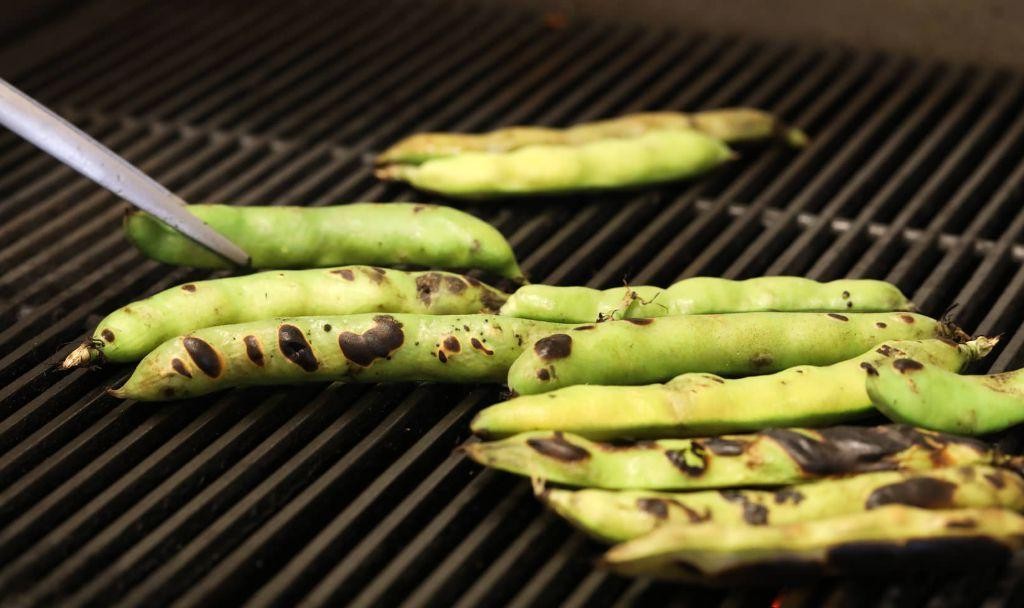
Warm spring afternoons call for dishes that celebrate the season’s bounty, and these grilled fava bean skewers deliver exactly that. Tender, buttery beans pair beautifully with aromatic herbs and a bright citrus marinade, creating a sophisticated yet approachable appetizer. Perfect for alfresco dining, they transform simple ingredients into an elegant presentation worthy of any gathering.
8
skewers47
minutes8
minutesIngredients
– 2 cups fresh fava beans, shelled from their vibrant green pods
– 1/4 cup golden extra virgin olive oil
– 2 tablespoons freshly squeezed lemon juice
– 2 cloves aromatic garlic, finely minced
– 1 teaspoon flaky sea salt
– 1/2 teaspoon freshly cracked black pepper
– 8-10 sturdy wooden skewers, soaked in cold water
– 2 tablespoons finely chopped fresh mint leaves
Instructions
1. Soak 8-10 wooden skewers in cold water for 30 minutes to prevent burning during grilling.
2. Blanch 2 cups shelled fava beans in boiling water for 2 minutes until bright green and slightly tender.
3. Immediately transfer blanched beans to an ice water bath to stop the cooking process and preserve their vibrant color.
4. Carefully peel away the outer skin from each fava bean to reveal the tender inner bean.
5. In a medium bowl, whisk together 1/4 cup golden extra virgin olive oil, 2 tablespoons freshly squeezed lemon juice, and 2 cloves finely minced garlic.
6. Add peeled fava beans to the marinade and gently toss to coat evenly.
7. Let the beans marinate at room temperature for 15 minutes to absorb the flavors.
8. Thread marinated fava beans onto the soaked skewers, spacing them evenly with about 1/4 inch between each bean.
9. Preheat your grill to medium-high heat, approximately 400°F.
10. Place skewers on the hot grill and cook for 3-4 minutes per side, until lightly charred and heated through.
11. Remove skewers from grill and immediately sprinkle with 1 teaspoon flaky sea salt and 1/2 teaspoon freshly cracked black pepper.
12. Garnish with 2 tablespoons finely chopped fresh mint leaves just before serving.
Vibrant and satisfying, these skewers offer a delightful contrast of textures—the slight char from grilling gives way to creamy, buttery interiors. The bright acidity of lemon and freshness of mint elevate the earthy fava beans beautifully. For an elegant presentation, arrange them over a bed of creamy ricotta or alongside grilled artisan bread to soak up the flavorful marinade.
Minted Fava Bean Risotto
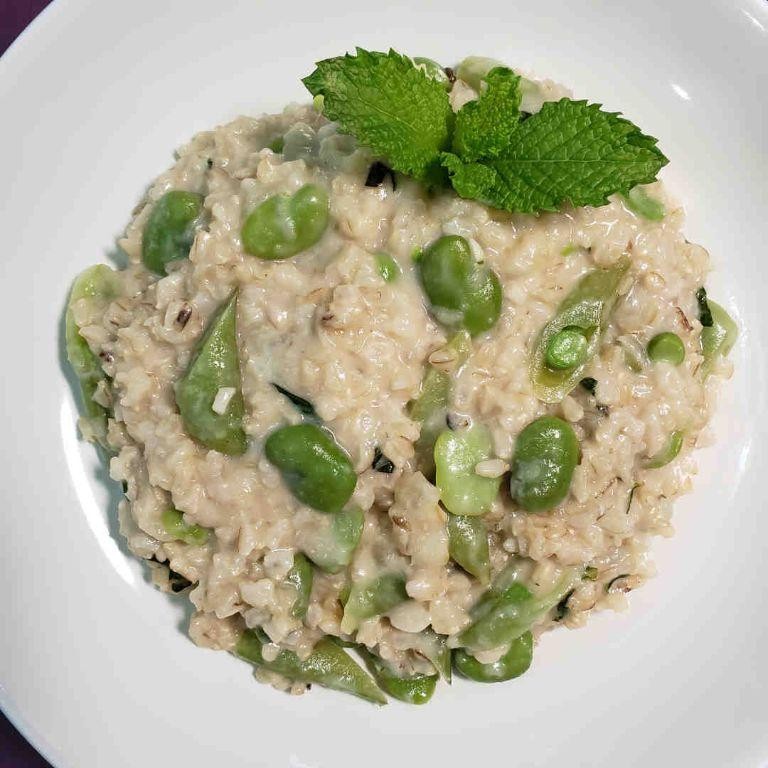
On brisk autumn afternoons when the light turns golden and the air carries that distinct crispness, nothing satisfies quite like a bowl of creamy, comforting risotto. Our minted fava bean version elevates this classic with the vibrant, earthy sweetness of fresh legumes and the bright, aromatic lift of garden herbs. It’s a dish that feels both elegantly sophisticated and deeply nourishing, perfect for a quiet weeknight or an intimate dinner gathering.
5
servings20
minutes35
minutesIngredients
- 1 cup Carnaroli rice
- 4 cups rich homemade chicken stock
- 1 cup fresh shelled fava beans
- 1/2 cup finely grated Parmigiano-Reggiano cheese
- 1/4 cup fresh mint leaves
- 1 small yellow onion, finely diced
- 2 cloves fragrant garlic, minced
- 1/2 cup dry white wine
- 3 tablespoons rich extra virgin olive oil
- 2 tablespoons unsalted European-style butter
- 1/2 teaspoon fine sea salt
- 1/4 teaspoon freshly cracked black pepper
Instructions
- Pour the chicken stock into a medium saucepan and heat over medium-low heat until it maintains a steady simmer at 180°F.
- Heat 2 tablespoons of extra virgin olive oil in a heavy-bottomed Dutch oven over medium heat until it shimmers.
- Add the finely diced onion and cook for 5-7 minutes, stirring occasionally, until translucent and fragrant but not browned.
- Stir in the minced garlic and cook for 1 minute until aromatic.
- Add the Carnaroli rice and toast for 2 minutes, stirring constantly, until the grains become slightly translucent at the edges.
- Pour in the dry white wine and cook, stirring continuously, until the liquid is fully absorbed, about 2 minutes.
- Ladle in 1/2 cup of the warm stock and stir continuously until the liquid is nearly absorbed, about 3-4 minutes.
- Continue adding stock in 1/2 cup increments, stirring constantly and allowing each addition to be absorbed before adding the next, for 18-20 minutes total.
- Meanwhile, blanch the fresh shelled fava beans in boiling water for 2 minutes, then transfer to an ice bath to preserve their vibrant green color.
- Peel the outer skins from the blanched fava beans to reveal the tender, bright green beans inside.
- When the rice is al dente and creamy but still has a slight bite, stir in the peeled fava beans, fine sea salt, and freshly cracked black pepper.
- Remove the risotto from heat and vigorously stir in the Parmigiano-Reggiano cheese, European-style butter, and remaining 1 tablespoon of extra virgin olive oil until fully incorporated and glossy.
- Fold in the fresh mint leaves just before serving to maintain their bright flavor and color.
What emerges is a risotto of remarkable texture—creamy yet distinct grains suspended in a luxurious broth that clings perfectly to each spoonful. The fava beans provide delightful pops of earthy sweetness, while the mint offers a refreshing counterpoint that cuts through the richness. For an elegant presentation, garnish with additional mint leaves and a drizzle of your finest olive oil, perhaps accompanied by a crisp white wine to complement the dish’s bright, herbal notes.
Authentic Greek Fava Bean Bread
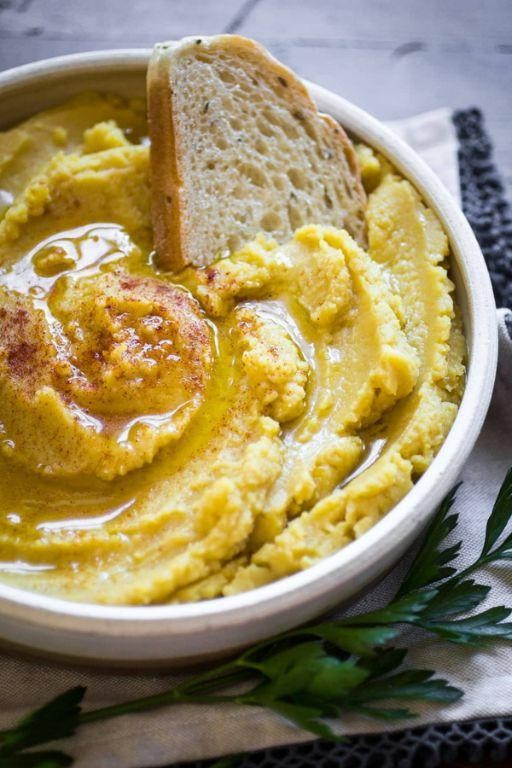
Yellow split peas transform into a velvety masterpiece in this traditional Greek fava bean bread, where centuries of Mediterranean culinary heritage meet contemporary baking artistry. The humble legume becomes the star in this golden-hued loaf, offering a delicate nuttiness that pairs beautifully with the subtle tang of fermented dough. This bread carries the soul of Greek tavernas into your kitchen, perfect for tearing and sharing over lively conversation.
1
loaf30
minutes120
minutesIngredients
- 1 cup dried yellow split peas, carefully rinsed
- 3 cups warm water (110°F)
- 2 ¼ teaspoons active dry yeast
- 1 tablespoon golden honey
- 4 cups all-purpose flour, plus extra for dusting
- 1 ½ teaspoons fine sea salt
- ¼ cup rich extra virgin olive oil
- 1 tablespoon fresh lemon juice
- 1 teaspoon dried oregano, fragrant and crumbled
- 1 large egg, beaten with 1 tablespoon water for egg wash
- 2 tablespoons sesame seeds, lightly toasted
Instructions
- Combine the warm water, active dry yeast, and golden honey in a large mixing bowl, then let it stand for exactly 10 minutes until foamy and fragrant.
- Cook the rinsed yellow split peas in 4 cups of water over medium heat for 45 minutes until completely tender and easily mashed with a fork.
- Drain the cooked split peas thoroughly, then mash them into a smooth paste using a potato masher or food processor.
- Add the split pea puree, all-purpose flour, fine sea salt, extra virgin olive oil, fresh lemon juice, and crumbled dried oregano to the yeast mixture.
- Mix with a wooden spoon until a shaggy dough forms, then knead on a lightly floured surface for 8-10 minutes until smooth and elastic.
- Place the dough in a lightly oiled bowl, cover with a damp kitchen towel, and let rise in a warm place for 1 hour 30 minutes until doubled in size.
- Punch down the risen dough gently to release air bubbles, then shape into a round loaf on a parchment-lined baking sheet.
- Cover the shaped loaf with the damp towel and let rise for 45 minutes until puffy and slightly springy to the touch.
- Preheat your oven to 375°F during the final 15 minutes of the second rise.
- Brush the entire surface of the loaf with the egg wash using a pastry brush, ensuring even coverage.
- Sprinkle the toasted sesame seeds generously over the top of the loaf, pressing lightly to adhere.
- Score the top of the loaf with a sharp knife in a crisscross pattern, making cuts about ¼-inch deep.
- Bake for 35-40 minutes until the crust is deep golden brown and the loaf sounds hollow when tapped on the bottom.
- Transfer the baked bread to a wire rack and let cool completely for at least 2 hours before slicing.
This bread achieves a remarkable crumb—moist and tender with the subtle earthiness of split peas balancing the olive oil’s fruitiness. The sesame seeds create a delightful crunch against the soft interior, while the oregano whispers of sun-drenched Greek hillsides. Try thick slices toasted and drizzled with honey for breakfast, or serve alongside roasted vegetables and feta for a complete Mediterranean experience.
Fava Bean and Lemon Pilaf

A vibrant celebration of spring’s arrival, this fava bean and lemon pilaf transforms humble grains into an elegant centerpiece, where bright citrus notes dance with earthy legumes against a backdrop of fragrant, perfectly cooked rice. The dish captures that fleeting moment when winter’s chill gives way to warmer days, offering both comfort and renewal in each flavorful forkful.
3
servings20
minutes25
minutesIngredients
– 1 ½ cups long-grain basmati rice
– 2 cups shelled fresh fava beans
– 1 large lemon, freshly zested and juiced
– 3 tablespoons rich extra virgin olive oil
– 1 small yellow onion, finely diced
– 2 cloves garlic, minced
– 3 cups vegetable broth
– 1 teaspoon coarse sea salt
– ½ teaspoon freshly cracked black pepper
– ¼ cup chopped fresh mint leaves
Instructions
1. Rinse 1 ½ cups long-grain basmati rice under cold running water until the water runs clear, about 2 minutes.
2. Heat 3 tablespoons rich extra virgin olive oil in a heavy-bottomed saucepan over medium heat until shimmering.
3. Add 1 small finely diced yellow onion and cook until translucent and softened, about 5 minutes.
4. Stir in 2 cloves minced garlic and cook until fragrant, about 30 seconds.
5. Add the rinsed rice to the pan and toast for 2 minutes, stirring constantly until grains appear slightly opaque.
6. Pour in 3 cups vegetable broth, 1 teaspoon coarse sea salt, and ½ teaspoon freshly cracked black pepper.
7. Bring the mixture to a boil, then immediately reduce heat to low and cover with a tight-fitting lid.
8. Simmer for 15 minutes without lifting the lid to ensure even steam distribution.
9. While rice cooks, blanch 2 cups shelled fresh fava beans in boiling water for 2 minutes.
10. Transfer blanched fava beans to an ice bath to stop cooking and preserve their vibrant green color.
11. Peel the outer skins from the fava beans to reveal the tender inner beans.
12. After 15 minutes, remove the rice from heat and let stand covered for 5 minutes to complete absorption.
13. Fluff the cooked rice with a fork to separate grains without crushing them.
14. Gently fold in the peeled fava beans, the zest and juice of 1 large lemon, and ¼ cup chopped fresh mint leaves.
15. Let the pilaf rest for 2 minutes to allow flavors to meld before serving.
The finished pilaf presents with distinct, separate grains that yield gently to the bite, while the fava beans provide satisfying pops of texture against the citrus-kissed rice. This dish shines as a sophisticated vegetarian main when accompanied by grilled asparagus, or makes an elegant partner to simply prepared fish, where its bright acidity cuts through richer flavors beautifully.
Stuffed Vine Leaves with Fava Beans
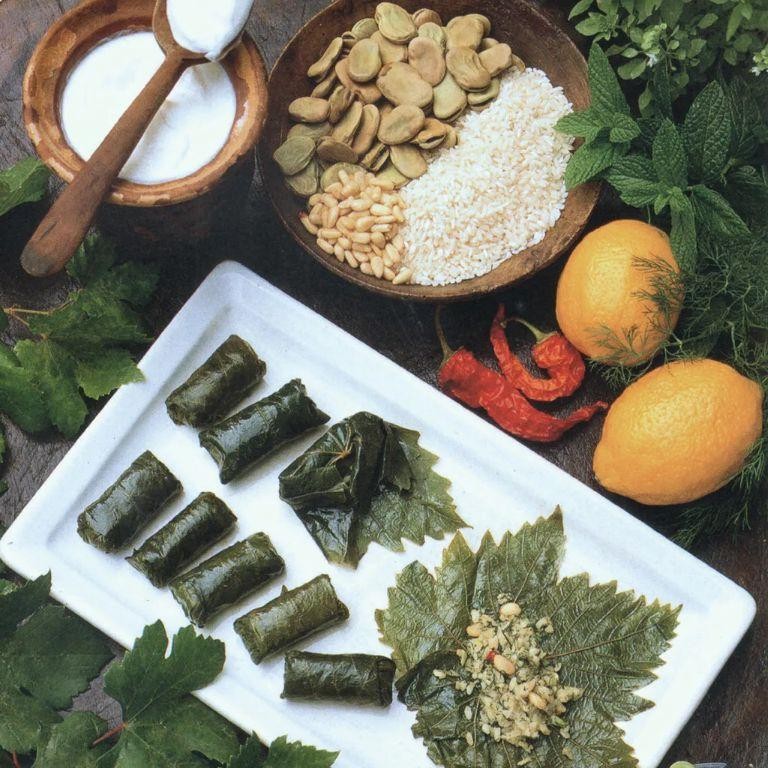
Verdant, aromatic parcels of culinary tradition, stuffed vine leaves with fava beans offer a taste of Mediterranean elegance that feels both ancient and refreshingly contemporary. These delicate bundles, carefully rolled around a savory filling, transform simple ingredients into an extraordinary dish perfect for gatherings or quiet appreciation. Their vibrant flavors and satisfying textures make them equally suited as an impressive appetizer or light main course.
20
rolls30
minutes50
minutesIngredients
- 1 jar brined vine leaves, thoroughly rinsed
- 1 cup fresh fava beans, shelled and peeled
- 1 cup medium-grain white rice, rinsed until water runs clear
- 1/2 cup rich extra virgin olive oil
- 1/4 cup freshly squeezed lemon juice
- 1/4 cup finely chopped fresh dill
- 1/4 cup finely chopped fresh mint
- 2 tablespoons finely chopped fresh parsley
- 1 small yellow onion, finely diced
- 2 cloves garlic, minced
- 1 teaspoon sea salt
- 1/2 teaspoon freshly ground black pepper
- 1/4 teaspoon ground allspice
- 2 cups vegetable broth
- 1 lemon, thinly sliced
Instructions
- Place brined vine leaves in a large bowl and cover with warm water for 15 minutes to remove excess salt, then drain and pat dry with paper towels.
- Heat 2 tablespoons of extra virgin olive oil in a skillet over medium heat until shimmering.
- Sauté finely diced yellow onion for 4-5 minutes until translucent and fragrant.
- Add minced garlic and cook for 1 minute until aromatic but not browned.
- Stir in rinsed medium-grain white rice and cook for 2 minutes, coating each grain with oil.
- Remove skillet from heat and mix in shelled fava beans, chopped dill, mint, parsley, sea salt, black pepper, and ground allspice.
- Lay one vine leaf vein-side up on a clean surface and place 1 tablespoon of filling near the stem end.
- Fold the bottom over the filling, then fold in the sides, and roll tightly into a compact cylinder. Tip: Roll snugly but not too tight to allow rice expansion during cooking.
- Repeat with remaining leaves and filling, arranging rolls seam-side down in a single layer in a heavy pot.
- Drizzle remaining extra virgin olive oil and freshly squeezed lemon juice over the arranged rolls.
- Place thinly sliced lemon rounds over the top layer of rolls.
- Pour vegetable broth over everything until liquid just covers the rolls. Tip: Place a heatproof plate directly on top of rolls to prevent them from floating during cooking.
- Bring to a gentle simmer over medium heat, then reduce to low, cover, and cook for 45 minutes. Tip: Check at 35 minutes—rice should be tender and liquid mostly absorbed.
- Remove from heat and let rest covered for 15 minutes to allow flavors to meld.
Notably tender yet satisfyingly firm, these vine leaf parcels offer a delightful contrast between the silky wrapper and the toothsome rice-fava bean filling. The bright citrus notes from the fresh lemon juice cut beautifully through the earthy beans and aromatic herbs. For an elegant presentation, arrange them on a platter with additional lemon wedges and a drizzle of your best olive oil, perhaps accompanied by a simple yogurt dip flecked with mint.
Fava Bean and Spinach Pie

Oozing with rustic charm and Mediterranean flair, this savory pie marries tender fava beans with vibrant spinach in a golden, flaky crust. Each slice reveals a harmonious blend of earthy legumes and delicate greens, elevated by aromatic herbs and creamy cheese. Perfect for brunch gatherings or elegant weeknight dinners, it transforms humble ingredients into a sophisticated centerpiece.
6
servings25
minutes35
minutesIngredients
– 2 cups shelled fresh fava beans
– 4 cups loosely packed baby spinach leaves
– 1 sheet frozen puff pastry, thawed
– 1 cup crumbled feta cheese
– 1/2 cup finely grated Parmesan cheese
– 1/4 cup rich extra-virgin olive oil
– 1 large farm-fresh egg, lightly beaten
– 3 cloves aromatic garlic, minced
– 2 tablespoons freshly squeezed lemon juice
– 1 teaspoon finely chopped fresh rosemary
– 1/2 teaspoon flaky sea salt
– 1/4 teaspoon freshly cracked black pepper
Instructions
1. Preheat your oven to 400°F and line a baking sheet with parchment paper.
2. Bring a medium pot of salted water to a rolling boil and blanch the shelled fresh fava beans for 2 minutes until bright green.
3. Immediately transfer the blanched fava beans to an ice bath to stop the cooking process, then peel away the outer skins.
4. Heat 2 tablespoons of rich extra-virgin olive oil in a large skillet over medium heat until shimmering.
5. Sauté the minced aromatic garlic for 1 minute until fragrant but not browned.
6. Add the baby spinach leaves and cook for 2-3 minutes until just wilted, stirring constantly.
7. Combine the peeled fava beans, wilted spinach, crumbled feta cheese, finely grated Parmesan cheese, remaining olive oil, freshly squeezed lemon juice, chopped fresh rosemary, flaky sea salt, and freshly cracked black pepper in a large bowl.
8. Unfold the thawed puff pastry sheet onto the prepared baking sheet and gently roll it out to a 10×12-inch rectangle.
9. Spoon the fava bean and spinach mixture onto the center of the pastry, leaving a 2-inch border on all sides.
10. Fold the pastry edges over the filling, pleating the corners neatly to create a rustic galette shape.
11. Brush the pastry edges with the lightly beaten farm-fresh egg using a pastry brush.
12. Bake for 25-30 minutes until the crust is puffed and golden brown and the filling is bubbling.
13. Let the pie rest for 10 minutes before slicing to allow the filling to set.
Hearty yet refined, this pie offers a delightful contrast between the flaky, buttery crust and the creamy, herbaceous filling. The fava beans provide subtle nuttiness against the spinach’s earthy notes, while the cheeses create pockets of salty richness. Serve warm with a crisp green salad dressed in lemon vinaigrette for a complete meal that celebrates spring’s bounty.
Baked Fava Bean Mousaka
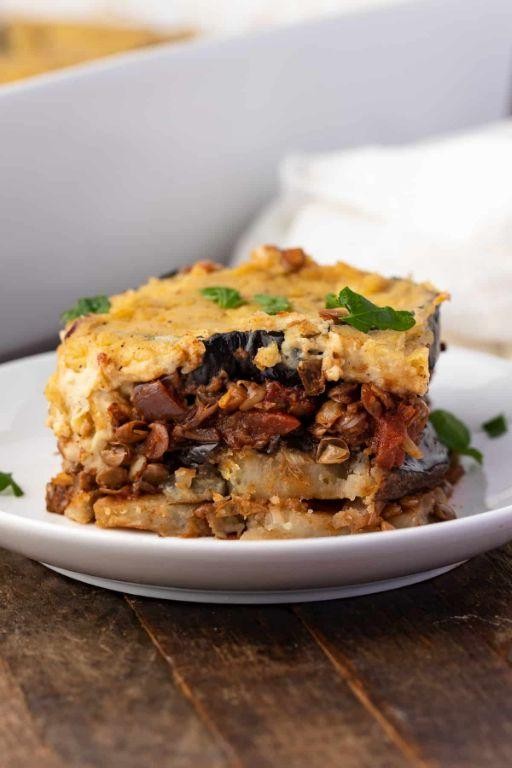
Delicately layered and deeply comforting, this baked fava bean moussaka reimagines the classic Mediterranean dish with vibrant plant-based elegance. Featuring tender fava beans nestled between silky eggplant slices and crowned with a velvety béchamel, it offers both sophistication and soul-warming satisfaction. Perfect for entertaining or a special family dinner, this dish celebrates the harmonious balance of textures and flavors that define exceptional comfort food.
6
servings30
minutes165
minutesIngredients
– 2 large globe eggplants, sliced into ¼-inch rounds
– 1 cup dried fava beans, soaked overnight
– 3 tablespoons rich extra virgin olive oil
– 1 medium yellow onion, finely diced
– 2 cloves garlic, minced
– 1 (14.5-ounce) can crushed San Marzano tomatoes
– ½ teaspoon ground cinnamon
– ¼ teaspoon freshly grated nutmeg
– 4 tablespoons unsalted butter
– ¼ cup all-purpose flour
– 2 cups whole milk, warmed
– ¼ teaspoon fine sea salt
– ¼ teaspoon freshly ground black pepper
Instructions
1. Preheat your oven to 400°F and line two baking sheets with parchment paper.
2. Arrange the eggplant slices in a single layer on the prepared baking sheets, brush both sides with 2 tablespoons of olive oil, and bake for 20 minutes until golden and tender.
3. While the eggplant bakes, drain the soaked fava beans and simmer them in fresh water for 45 minutes until fully tender, then drain thoroughly.
4. Heat the remaining 1 tablespoon of olive oil in a large skillet over medium heat, add the diced onion, and sauté for 6–8 minutes until translucent and fragrant.
5. Stir in the minced garlic and cook for 1 minute until aromatic but not browned.
6. Add the crushed tomatoes, cooked fava beans, cinnamon, and nutmeg to the skillet, reduce heat to low, and simmer for 15 minutes until the sauce thickens slightly.
7. In a separate saucepan, melt the butter over medium heat, whisk in the flour, and cook for 2 minutes to form a pale golden roux.
8. Gradually pour in the warmed milk while whisking continuously to prevent lumps, and cook for 5–7 minutes until the sauce thickens to a creamy consistency.
9. Season the béchamel sauce with salt and pepper, then remove from heat.
10. In a 9×13-inch baking dish, layer half of the roasted eggplant slices, spread the fava bean-tomato mixture evenly over them, and top with the remaining eggplant.
11. Pour the béchamel sauce over the final layer, using a spatula to spread it smoothly.
12. Bake at 375°F for 35–40 minutes until the top is golden brown and bubbly.
13. Let the moussaka rest for 15 minutes before slicing to allow the layers to set. Layered with care and baked to perfection, this moussaka emerges with a crisp golden crust giving way to creamy interiors and the earthy sweetness of fava beans. The subtle warmth of cinnamon and nutmeg lingers elegantly alongside the tangy tomato sauce, creating a symphony of Mediterranean flavors. Serve it alongside a crisp arugula salad dressed with lemon vinaigrette to complement its rich, comforting layers.
Fava Bean Bruschetta with Capers

Zestful spring flavors find their perfect expression in this sophisticated bruschetta, where creamy fava beans meet briny capers atop crisp, golden toast. This elegant appetizer transforms humble ingredients into a culinary masterpiece that celebrates seasonal abundance. Each bite offers a harmonious balance of textures and bright, herbaceous notes that awaken the palate.
4
servings15
minutes13
minutesIngredients
– 1 pound fresh fava beans in their pods
– 4 thick slices of artisanal sourdough bread
– 2 tablespoons rich extra-virgin olive oil
– 1 tablespoon briny capers, drained
– 1 small garlic clove, peeled
– 2 tablespoons freshly squeezed lemon juice
– ¼ cup finely chopped fresh mint leaves
– ½ teaspoon flaky sea salt
– ¼ teaspoon freshly cracked black pepper
Instructions
1. Remove fava beans from their pods and place them in a medium saucepan.
2. Cover beans with water and bring to a rolling boil over high heat.
3. Cook beans for exactly 3 minutes until their outer skins begin to loosen.
4. Immediately transfer beans to an ice water bath using a slotted spoon to stop the cooking process.
5. Gently squeeze each bean between your thumb and forefinger to pop them from their tough outer skins, reserving only the bright green inner beans.
6. Preheat your oven to 375°F and arrange sourdough slices on a baking sheet.
7. Brush both sides of each bread slice generously with extra-virgin olive oil.
8. Toast bread in the preheated oven for 8-10 minutes until edges turn golden brown and surfaces become crisp.
9. Rub one side of each warm toast slice with the peeled garlic clove for subtle aromatic flavor.
10. In a medium bowl, combine peeled fava beans, capers, lemon juice, chopped mint, sea salt, and black pepper.
11. Gently mash about one-third of the bean mixture with a fork to create a creamy base while leaving remaining beans whole for texture contrast.
12. Spoon the fava bean mixture evenly over the garlic-rubbed toast slices, pressing lightly to adhere.
13. Drizzle any remaining olive oil from the bowl over the finished bruschetta for extra sheen and flavor.
Creating an irresistible textural experience, the creamy fava beans contrast beautifully with the crisp, charred bread while briny capers provide surprising bursts of flavor. Consider serving these elegant toasts alongside a crisp rosé or as the star of an alfresco spring gathering, where their vibrant green hue and fresh aroma will captivate your guests from the first glance.
Conclusion
Outstanding! These 25 Greek fava bean recipes showcase how versatile and delicious this humble legume can be. From creamy dips to hearty mains, there’s something for every home cook to love. We hope you’ll try a few, leave a comment with your favorites, and share this article on Pinterest to spread the Greek culinary love!



